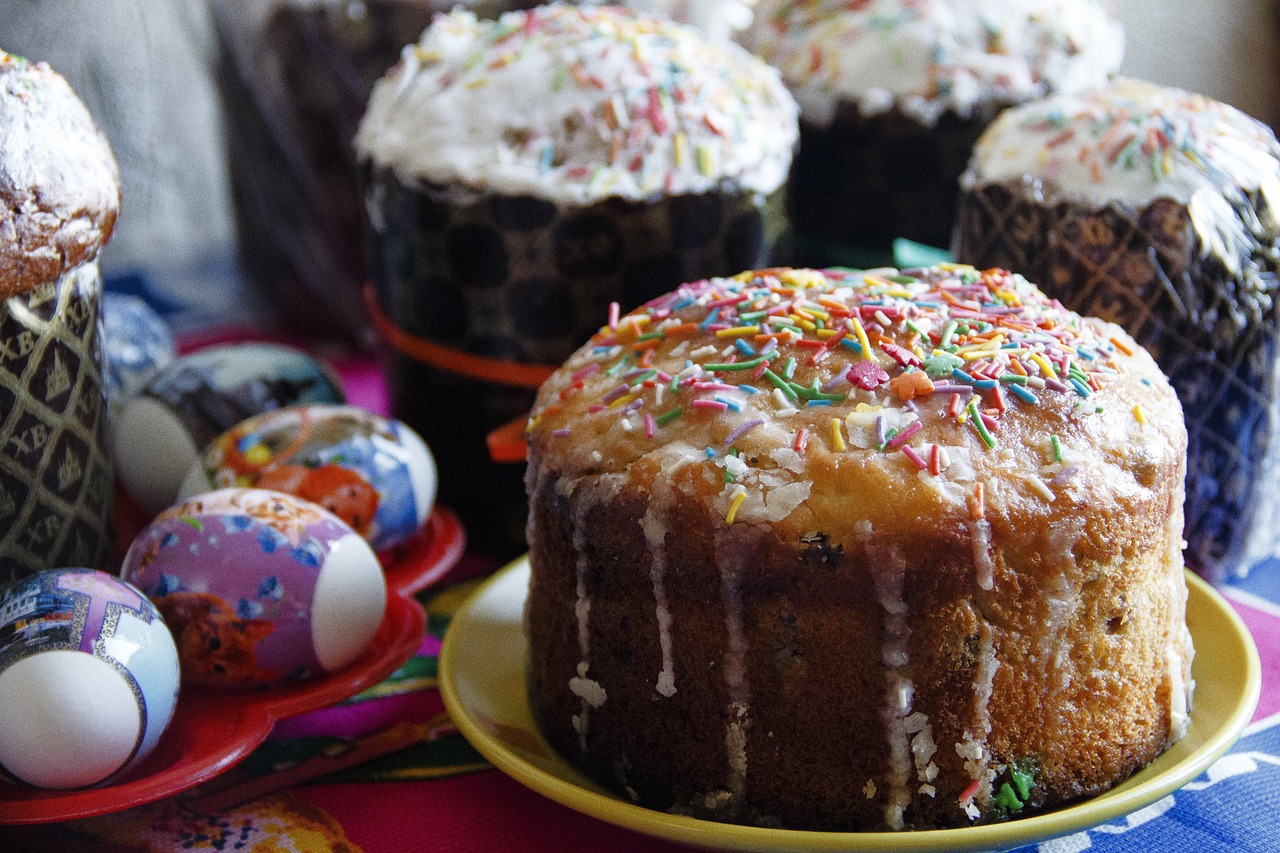Orthodox Easter is celebrated this year on May 5th. Let’s start preparing for it in advance and talk about how to make kulich for the festive table. London Cult’s culinary journalist Lyuba Safonova shared her favorite recipe, which doesn’t require any special skills — just a pile of dried fruits, butter, flour, and a lot of time.
Easter kulich is a heavy ceremonial pastry, and many avoid making it because they remember how grandmothers and mothers spent the whole day in the kitchen on the eve of Easter. In fact, making kulich is not that difficult. We offer a simplified version: it still has many ingredients, but the preparation, although stretched over two days, requires minimal attention.
Ingredients:
- Dry yeast — 11 g
- Milk — 30 m
- lChicken eggs — 6 pieces
- Flour — 550 g
- Sugar — 60 g
- Salt — 2 teaspoons
- Vanilla extract — 1 tablespoon
- Butter — 400 g
- Raisins — 100 g
- Dried cherries — 100 g
- Dried currants — 100 g
- Saffron — a pinch
- Dark rum — 75 ml for dried fruits and 3 tablespoons for soaking saffron
Glaze ingredients:
- Powdered sugar — 150 g
- Water — 40 ml
Details:
- Preparing kulich according to this recipe will take two days (yes!). On the first evening, you’ll need about three hours to knead and let the dough rise, and on the second day, about the same amount of time for baking and decorating.
- If you prefer to use fresh yeast, you’ll need three times more than dry ones: not 11 grams, but 33.
- For kulich, you should use strong flour with a high protein content — look for Strong Bread Flour. Ideally, the protein content should be 11-12 grams per 100 grams of flour.
- The dough for kulich is very sticky. This is normal; don’t try to knead it until smooth. Instead, set a timer for kneading and stop when it rings.
- You can use dark or light rum, but any strong alcohol will do (e.g., cognac, whiskey, or brandy). In such a heavy dough as kulich, alcohol is needed not only to add flavor but also to help the dough rise better.
- Any dried fruits will do, but raisins, dried cherries, and dried currants are the easiest to find. Feel free to substitute them with your favorites!
- For kneading the dough for kulich, it’s best to use a powerful stand mixer. Regular mixers with hook attachments rarely withstand long-term work, so if you don’t have a stand mixer, it’s better to knead the dough by hand to avoid burning out the equipment (the recipe assumes that the dough is kneaded by hand).
- Try to find a companion. Baking kulich alone is not difficult, but you’ll definitely need someone to help you when you get stuck in the dough up to your elbows and need to add ingredients.
- Paper molds for kulich are sold in Eastern European stores. Fortunately, much more common panettone molds are easily found online. The recipe is for three medium-sized kulich. If you don’t have molds on hand, you can use enamel bowls with high sides, iron cups, or even tin cans for baking. In this case, cut out a circle of parchment paper the size of the bottom and a rectangle long enough to roll into a tube. Secure with a small piece of tape.
- It’s considered proper to add room temperature butter to the kulich and mix it in for a long time, achieving even distribution throughout the mass. This works when you have a stand mixer; otherwise, gradually adding the butter makes the process exhausting and labor-intensive. So, we’ll melt the butter—the taste of the kulich won’t suffer, the texture will change insignificantly, and you’ll have the energy to paint the eggs or do something enjoyable.
- You’ll need a very large bowl for kneading. The bigger, the better: after kneading, the dough will need to rise in the refrigerator overnight, and it’s important that it doesn’t overflow.
- Sometimes the yeast may not be strong enough, or you may have made a mistake with the calculations, and after the first rising, the dough may not rise enough. You can fix this: dissolve the yeast in a very small amount of milk, and when it turns into foam, gently mix it into the dough.
- Saffron is needed to give the kulich a festive golden color, but you can do without it.
How to cook:
- Steep a pinch of saffron in three tablespoons of rum (or any other alcohol you have at home). Set aside to infuse. Stir occasionally to speed up the pigment extraction. When the rum becomes saturated with color, remove the spice from it.
- Slightly heat the milk to about 40 degrees Celsius—it should be warm but not hot. Dissolve the yeast with half a teaspoon of sugar in it and also set aside. It will take about 10 minutes for them to activate. If the yeast doesn’t wake up, you can try placing the container with them in warm water.
- Put the cherries, currants, and raisins in a saucepan, pour in the rum, and start heating over low heat. In about 10-15 minutes, the rum will be absorbed—remove the saucepan from the heat and let it cool.
- Melt the butter and let it cool to room temperature.
- In a large bowl, break the eggs, add the butter, yeast with milk, saffron infusion, and vanilla extract, as well as sugar and salt. Mix well.
- Pour all the flour and dried fruits into the egg mixture, mix gently, cover with a towel, and leave for 15 minutes. Don’t knead anything yet—just combine the ingredients and wait. During this time, gluten will develop in the dough, and further kneading will be much easier.
- When the dough has a more or less uniform texture, transfer it to a floured surface and continue kneading. Set a timer for 10 minutes—this is enough time. The dough will be sticky—that’s how it should be!
- Return the dough to the bowl, cover with a towel, and leave for one and a half hours
- Punch down the dough, transfer it to a clean bowl, cover with a lid or plastic wrap, and refrigerate for 8-12 hours.
- Let’s start baking. The kulich molds should be filled one-third full. Roll each part of the dough into a ball and place it in the mold. When all the dough is in the molds, cover them with a towel and leave for an hour and a half in the oven or in another warm place. Check on them occasionally: the dough should rise 2-3 times.
- Preheat the oven (without the kuliches inside) to 160 degrees Celsius. Depending on the size, baking will take from 35 minutes to an hour. You can check the readiness by inserting a wooden skewer or toothpick into the surface of the kulich—if it’s almost dry, they’re ready. If the kulich is not yet ready but the top is starting to brown, cover it with foil.
- Place the finished kuliches on their side to cool: this is to prevent them from collapsing. It’s best to do this on a rack.
- For the glaze, mix powdered sugar and water, vigorously stirring until you get a thick paste.
- You can simply dip the finished kuliches in the glaze or spoon it over them. Decorate with sprinkles or almond flakes.





